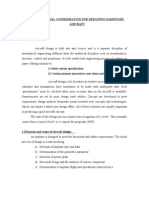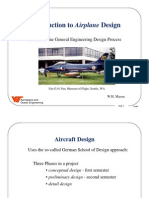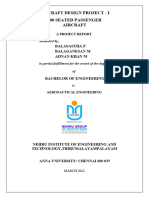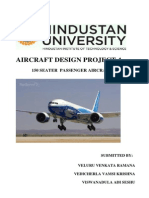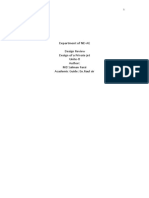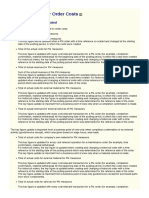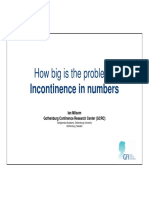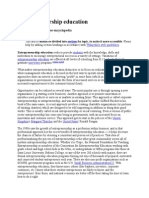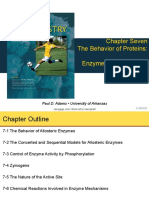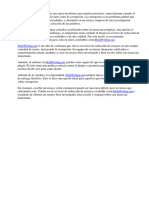Airplane Design
Lecture Topics
• Design steps
• Conceptual design
• Preliminary design
• Detailed design
• Weight estimation
1
� Preliminary Comments
• There are as many ways to design
airplanes as there are airplane
designers
• Design is an iterative process
• It has to be cost-effective
Finance
Boeing 777
Seven years to production cost $10B
~ $50M profit per airplane
=> 200 airplanes to break even
=> 50 months @ 4 airplanes / month
=> 11.2 years break even w/ bank yield
(In 11 years bank yield would be ~ $7B @ 5%)
2
� Decision to Build
• Market Analysis
• Design Specifications
• Costs
• Labor
• Competition
Market
• Airlines
• Military
• General Aviation
• Demand
• Growth
• Economy
3
� Civilian
• Airlines need to make money
• New routes sometimes profitable
• Boeing 767 was hub & spoke
“buster” for North Atlantic
• Boeing 777 & Airbus A340 try to do
same for Pacific
Military
• Old Method
– Military makes detailed specifications
– High cost
• New Method
– Minimal specs from military
– Companies must create internal specs.
• Future Method
– still in flux
4
� Airplanes Become Complex
• Up to mid 1940’s integration of all design elements
was under direction of one person
• B-29 was so complex that no one person could
comprehend it all
• Russians kept 3 B-29s after WWII
– They tore one apart & had each component duplicated.
– 2 yrs later they were flying exact duplicates
– One Russian official claimed that these airplanes were
so similar that “their engines caught fire too”
Design Specifications
?
• Specs passed on to engineering dept.
• Engineers come up w/ design to meet
performance goals
• In some cases, not all specs can be met
5
� General Design Specifications
• Payload
– Large size, High power, Low weight
• Cruising Speed
– Low drag, Small size, High power
• Range / Endurance
– Low weight, Low drag
– Low fuel consumption, Large fuel capacity
• Airports of Operation
– Takeoff distance
• High power, Large wing area, High lift airfoil, Low drag, Low weight
– Landing distance
• Large wing area, High lift airfoil, Low weight
• Cruise Altitude
– Climb rate and ceiling
– High power, Low drag, Low weight
Military Design Specifications
1) Functional rqmnt’s; air-to-air, air-to-ground, bomber, aerial
re-fueling tankers, transport
2) Performance rqmnts: payload, range, cruise speed, etc.
3) Design rqmnts: engineers specifies configuration to meet
performance goals
4) verification rqmnts:
a) inspection
b) analysis
c) demonstration (normal operating functions)
d) flight test
e) lifetime ?
6
� Performance (old paradigm)
• Lift to Drag ratio (“L over D”)
• Power to Weight ratio
• Wing Loading (TOGW / wing area)
• Weight
New Paradigm
• Cost
– Development / Engineering
– Retail price
– Lifetime maintenance
– Fuel consumption
• $Fuel ↑ Speed ↓
7
� Costs
sample only
People
Fuel Airline costs
Maint.
Ownership
Labor
Materials
Manufacturing costs Parts
Overhead
Labor
• Do we have the:
– Engineers ?
– Machinists ?
– Support network ?
8
� Competition
• Airbus / Boeing
• Existing airplanes
• Interchangeable parts
• International agreements
Competition
• Late 1960’s:
– Lockheed L-1011
– McDonnell-Douglas DC-10
• DC-10 / L-1011 direct competition
• Lockheed bowed out of commercial
business
9
� FAA Regulations
• Federal Aviation Administration
– Responsible for safety regulation of civil aircraft
• Part 23: Airworthiness Standards
– Come from crash investigations
– Normal, Utility, and Acrobatic Category
(< 12,500 lb TOGW)
• Part 25: Airworthiness Standards
– Transport Category Airplanes
( > 12,500 lb TOGW)
• Part 103: Ultralights
Design Steps
• Conceptual Design
– Basic characteristics considered
• Preliminary Design
– Aerodynamics, final configuration,
performance details
– Formal review, CEO involved
• Detailed Design
– Structural design
– Actual hardware and parts are drawn
10
� Conceptual Design
Jet engine powered
Or, propeller ?
Conceptual Design
Land based
Or, amphibian ?
11
� Conceptual Design
Wing mounted
Engines
(707, 737-787)
Or, tail
Mounted ?
(DC9, 717, 727)
Engine Location
B-17
12
� Engine Location - Fire
B-17
Engine Location - Landing Gear
B-52
13
�Engine Location - Stealth Capability
F-117A Retired 2008
(Prototype named “Have Blue” 60% scale)
Engine Location - Stealth Capability
Tacit Blue - 1996
14
�Engine Location - Compression Lift
XB-70 Valkyrie
Conceptual Design
• Most fun part: but few jobs
• AA101 airplane example
– 100 passenger commuter jet
– land-based
– tail mounted engines
– short fields (3,500 ft runways)
15
� Conceptual Design Goals
(AA101 Design Project)
• What requirements drive design ?
• What does it look like ?
• What trade-offs should be considered ?
• What should it cost ?
• Initial weight estimate ?
Preliminary Design
What do we do next ?
16
� Preliminary Design
• Expensive phase
• “Freeze configuration”
– Aerodynamics
• Develop lofting
– Detailed drawings
• Develop test and analytical base
– Wind tunnel
• Design major items
• Develop actual cost estimates
– Weight and performance estimates advertised
Freeze Configuration
• Basic layout done
• Engines selected
17
� Develop Lofting
Develop Test & Analytical Base
18
� Design Major Items
ribs
wing box
engine mounts
Develop Actual Cost Estimate
Parts
Avionics
Labor
Materials
124
19
� Preliminary Design
• More engineers required
• Many airplanes at this stage still do
not get built
• Many challenges
Detailed Design
• Design actual pieces to be built
• Design tooling and fabrication
• Test major items - structure,
landing gear, etc.
• Finalize weight and performance
estimates
20
� Parts Design
Design Tooling & Fabrication Process
21
� Parts Testing
landing gear
wing ultimate load test drop test
Finalize Weight & Performance
Estimates
? • Range
• Endurance
• Payload
1234
• Takeoff Weight
22
� Detailed Design
• Most of design labor is here
• Many engineers involved
• Can be less than exciting
– Individuals work in their specialized fields
• Failures still possible
– 1st commercial jet => British comet
– 2 major crashes
– Failures due to fatigue at windows
Primary Design Elements of Feasible Flight Vehicle
Aerodynamics
Forces sufficient to
lift & control vehicle
in sustained flight
Structures Propulsion
Materials & configurations of Engines of low weight & high
low weight & sufficient strength fuel efficiency with sufficient
to accommodate forces thrust to sustain flight
23
� AA101 Conceptual Design
• 100 passenger commuter jet
• 3,000 mile range
• tail mounted engines
• short fields (3,500 ft runways)
• made out of aluminum
Take-off Weight Buildup
Wo = Wcrew + Wpayload + Wfuel + Wempty
Wo is Design Takeoff Gross Weight
Wempty is dry weight of airplane, i.e.,
unloaded & unfueled
To start, assume Wo = 100,000 lb
24
� Empty Weight Estimation (Wempty)
0.6
0.575
0.55
0.525
AA101
W empty/ W o
0.5
0.475
0.45
existing designs
0.425
0.4 4
10 105 106
Takeoff Gross Weight
Wempty ~ 0.52 x Wo = 52,000 lb
Fuel Estimation
Mission Fuel Consumption
cruise: 300mi T.O. 0.03
loiter
Climb 0.02
Cruise 0.16
T.O. land Loiter 0.04
Landing 0.005
Reserve Fuel ? Fuel Fraction = 0.255
Wfuel = 0.255 x W0 = 25,500 lb
25
� Crew and Payload Weight
• Crew: 175 lb + 30 lb of baggage
– 205 lb per crew member
• Passengers: 175 lb + 35 lb bags
– 210 lb per passenger
5 crew * 205 lb + 100 passengers * 210 lb
=> Wcrew + Wpayload = 22,025 lb
Takeoff Weight Calculation
• Wcrew + Wpayload = 22,025 lb
• Wempty = 52,000 lb
• Wfuel = 25,500 lb
Result: TOGW = W0 = 99,525 lb
If not close, then re-iterate; i.e., adjust
payload, fuel, and/or initial mass and
determine impact on range…
26
�Weight Estimation Tool
Summary
• Design steps
• Conceptual design
• Preliminary design
• Detailed design
• Weight estimation
27
� Airbus A380
2007
W0 = 1,300,000 lb
$325 M
525 - 850 passengers
Boeing 747-800
W0 = 970,000 lb
$300 M
470 passengers
2008
28
� Sonic Cruiser
Mach 0.95
Cancelled 2002
Some features
incorporated in
New Boeing 787
New Fuel Efficient Concepts
29








